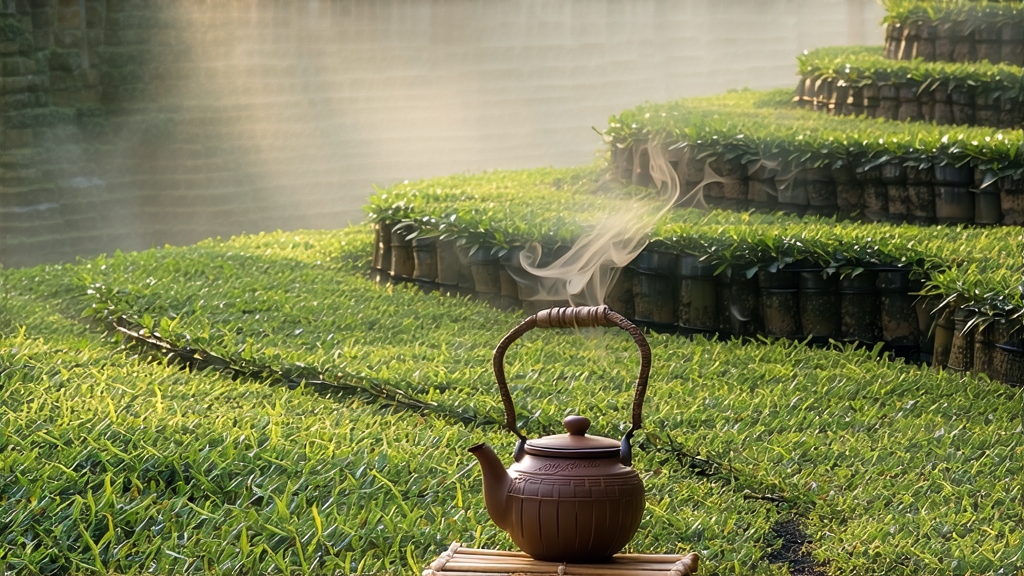
Tucked high on the mist-laden shoulders of Mt. Meng in Sichuan Province, Meng Ding Huang Ya has been whispering its mellow, corn-silk sweetness to Chinese palates for more than twelve centuries. Unlike the flash-fired green teas that surround it geographically, this “yellow bud” tea deliberately lingers in its own gentle vapor, acquiring a luminous golden liquor and a personality so refined that Song-dynasty emperors decreed it the sole libation worthy of ancestral rites. Today the tiny output—barely eighteen tons in a good spring—remains one of the least-known of China’s six tea families, yet for those who meet it, Meng Ding Huang Ya is a revelation: a bridge between the grassy clarity of green tea and the rounded depth of lightly oxidized oolong, carried across by a unique microbial “smothering” that turns leaf tips the color of warm honey.
History: From Daoist Altar to Imperial Tribute
Mt. Meng, “the place where the world’s rain is born,” was first planted during the Tang dynasty (618-907 CE) when Daoist monks discovered that cloud cover at 1,450 m moderated the harsh Sichuan sun, allowing the buds to remain small and amino-rich. By the Song (960-1279) the tea had become gong cha—tribute tea—carried 1,400 km by fast horse to Bianjing (modern Kaifeng) where it was presented to the emperor in tiny jade boxes. A 1066 court edict fixed the picking window at “three days either side of Qingming” and limited harvesters to 3,000 buds per person per day, a standard still observed by the 112 registered households of the Meng Ding micro-valley. After 1911 the tribute system collapsed; yellow tea techniques were quietly forgotten as green tea fetched quicker cash. It was not until 1979 that retired master Zuo Jinlong reconstructed the smothering protocol from a single 1894 parchment, reviving Meng Ding Huang Ya for modern drinkers.
Micro-ecology: Why the Mountain Matters
The garden zone sits just below the perennial cloud belt; humidity averages 88 % while temperature oscillates only 6 °C between day and night. The soil is a porous purple sandstone rich in selenium and zinc, elements that encourage the synthesis of l-theanine and aromatic geraniol. Because UV-B is filtered by mist, buds contain less catechin bitterness than low-altitude counterparts, giving the tea its hallmark sweetness.
Plucking Standard: One Bud, One Leaf, 2.2 cm
Harvest begins when 60 % of the bushes show the “sparrow’s tongue” stage—unopened buds 12–15 mm long accompanied by a single semi-open leaf no longer than 2.2 cm. Pickers wear cotton gloves to prevent enzymatic bruising and drop the shoots into bamboo baskets lined with fresh banana leaf; oxidation must not start until the tea master decides. Anything longer or rain-damaged is rejected, explaining why a kilo of finished tea needs 84,000 hand-picked tips.
Craft: The Secret of Men Huang – Slow Smothering
Meng Ding Huang Ya is the only yellow tea that undergoes three successive smothering (men huang) cycles, each lowering moisture while allowing non-pathogenic microbes to bloom.
-
Sha Qing – “Killing the Green”
Leaves are tumble-panned for 78–82 seconds at 160 °C in iron woks, just enough to denature polyphenol oxidase while preserving a 12 % moisture core. The aroma shifts from cut grass to fresh corn. -
Chu Bao – First Wrapping
Immediately after panning, the hot leaf is piled 8 cm deep inside square cotton bundles, then buried within a bamboo steamer lined with wet cheesecloth. Temperature drops from 55 °C to 38 °C over 90 minutes; humidity stays above 95 %. During this sauna-like rest, mesophilic bacteria hydrolyze proteins into free amino acids, producing a brothy umami precursor. -
Song Bao – “Loosening the Bundle”
Tea is gently fluffed to reintroduce oxygen, halting anaerobic fermentation. Leaf edges turn canary yellow; the center remains jade green. -
Er Bao & San Bao – Second & Third Wrapping
Cycles two and three last 60 and 45 minutes respectively, with target temperatures of 36 °C and 34 °C.